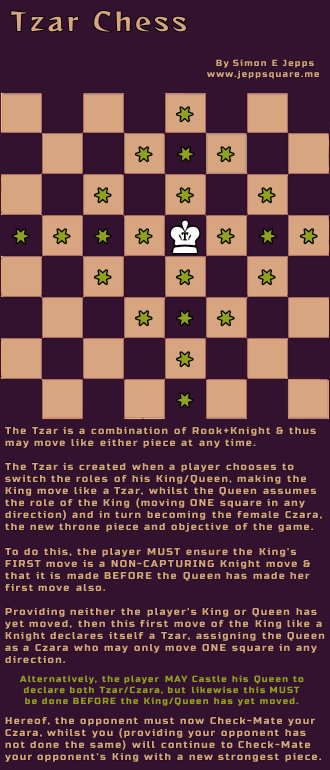TZAR CHESS
A Chess Variant By Simon Edward JeppsDownload ~ PDF ↷ ⋱ ⋱ Chatblog ⨗
How To Play
 Tzar Chess is a fantastic variant whereby a player's King and Queen may effectively "switch roles" ~ only instead of each piece becoming the exact other, the King becomes a Tzar (Rook+Knight combo) and the Queen becomes a Czara (female Tzar but moves only like a classical King).
Tzar Chess is a fantastic variant whereby a player's King and Queen may effectively "switch roles" ~ only instead of each piece becoming the exact other, the King becomes a Tzar (Rook+Knight combo) and the Queen becomes a Czara (female Tzar but moves only like a classical King).
I have long found the concept of the Queen going off to fight a war for her King to be unsettling and have often considered other ideas. Needless to say, in real life it is more likely that the King would go off and fight to defend his Queen: unless perhaps he is disabled and she is of the muscly variety.
Nevertheless, a subconscious adoration for the Classical game has always begged me to seek out new dimensions within the same foundations, so as to preserve its immeasurable academic heritage and allow any new evolution to thus transpose upon this heritage into a greatly augmented future.
Indeed, a paramount focus behind the scenes of my Chess Variant projects has been to create more substance from the same inventory and to evolve Chess without adding any more physical pieces or squares.
The reason is twofold: Firstly there are many issues with larger boards or extra pieces, both algorithmically and thematically, whereby the game always features an unwelcome anomaly of design ~ particularly with larger boards. Secondly, regardless of how popular any Chess Variant may have become, none such alternative 'evolutions' of the game have ever succeeded the Classical game loved immemorial, which aside from its miniscule yet ever nagging qwirks, is otherwise a mathematically perfect and almost 'sacred' design.
Yet it is true, Grandmasters have been saying for over a hundred years now that the game of Chess is becoming "played out" and needs to evolve ~ not just for elite players, but even at tournament level whereby one's good knowledge of Openings is imbalanced by the inability to reach elite depths of study, in turn resulting in a bugging boredom with common positions.
I have always seeked to find a single "key" which, whence unlocking merely one "square", would in turn augment the "infinite" possibilities of Chess to beyond the mere reach of Grandmasters and into the hands of all who would dare transcend other dimensions of Chess exploration.
Herewith, let me teach you Tzar Chess.
- The Tzar is a combination of Rook+Knight and thus may move like either piece at any time.
- This piece was first publicised under the name 'Chancellor' by José Capablanca in 1925 and has since been adopted by various other games, such as Seirawan Chess in which it is called an 'Elephant'.
- The Tzar is of equal value to a Queen (9+ points). Whilst a Queen is effectively a Rook + 1½ Bishops (9.71 points) and yet a Tzar is only a Rook + 1¼ Knights (8.75 points), the ability to leap your Rook equalizes the comparison.
- The Tzar is created when a player chooses to switch the roles of his/her King/Queen, making the King move like a Tzar, whilst the Queen assumes the role of the King (moving ONE square in any direction) and in turn becoming the female Czara, the new throne piece and objective of the game.
- To do this, the player MUST ensure the King's FIRST move is a NON-CAPTURING Knight move and that it is made BEFORE the Queen has made her first move also.
- Providing neither the player's King or Queen has yet moved, then this first move of the King like a Knight declares itself a Tzar, assigning the Queen as a Czara who may only move ONE square in any direction.
- [+] Alternatively, the player MAY Castle his Queen to declare both Tzar/Czara, but likewise this MUST be done BEFORE the King/Queen has yet moved.
- Herewith the opponent must now Check-Mate your Czara, whilst you (providing your opponent has not done the same) will continue to Check-Mate your opponent's King with a new strongest piece.
Herewith a King becomes a Tzar and a Queen becomes a Czara. Hereafter the Tzar is notated with a
' T ' and the Czara with a ' C '.
CHECK of course can still be given to a King which has not yet declared itself a Tzar, however the King MAY escape Check with the non-capturing Knight move declaring itself a Tzar instead. Yet, until either Tzar/Czara is declared, a Check MUST be addressed as per usual: thus BLOCKING Check is the best method of prolonging anonymity to still become a Tzar later.
CASTLING rules and notation remain the same, only whence it is the Czara who must now Castle, we notate this as "S~S" Queenside and "S~S~S" Kingside, as is commonly accepted 'Queen-Castling' notation in Chess Variant forums.
Castling the Queen as a declaration of Czara IS subject to the same restrictions as Castling the King; thus she MAY NOT be declared by Castling through/into Check.
If you didn't already know (and it's surprising how many people don't) the "O~O / S~S" & "O~O~O / S~S~S" notation refers to the number of squares the Rook must move, relative to each side. Thus here in Tzar Chess, 'Long Castle' and 'Short Castle' become the opposite relative destinations for the Czara.
Whence depicting the new pieces in game diagrams, it is actually possible to merely use the same symbols/images as per the King and Queen, since if one is actually following the game one would understand. However in case you would want to make it clear for observers who do not know the history of the position, or that it is a Chess Variant they are looking at, then I would purely indicate their new roles by attaching a ' T ' or ' C ' to each one respectively, much as I have done in the diagram here. However I do not personally assign any newly designed images for these pieces.
Please note, whilst the correct term for a female Tzar is actually 'tzarina' or 'czarina', being an eccentric game designer I chose to create my own good term, the Czara.
In conclusion and summary, I am extremely keen on this variant as a prime candidate for evolving Chess because it ticks all the boxes and offers a fantastical new treasure trove of infinite gameplay possibilities.
Thank you for reading.
Chatblog ⨗
 |  |





